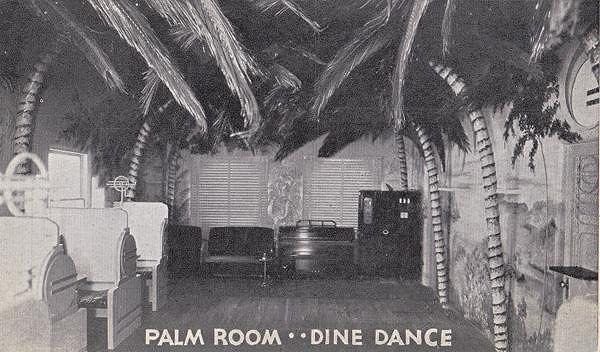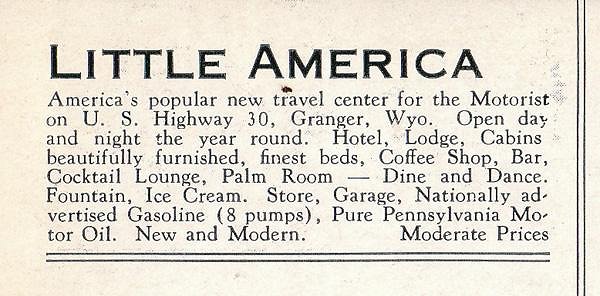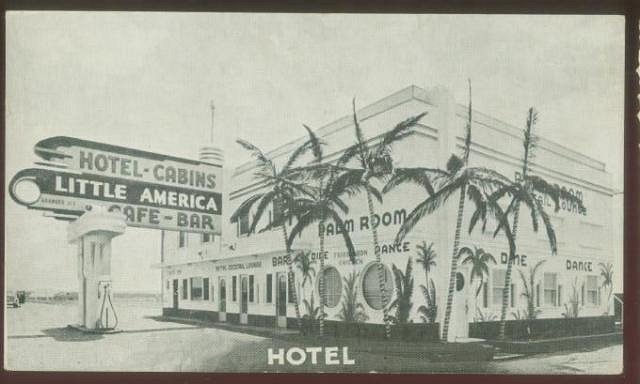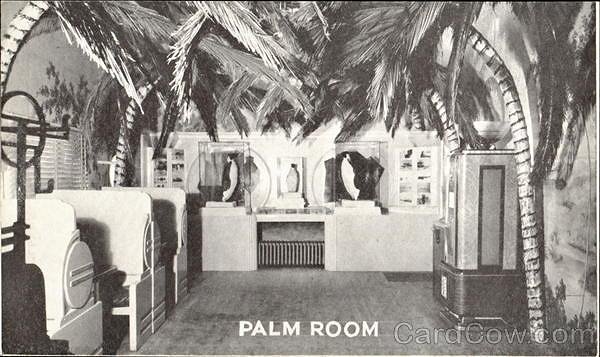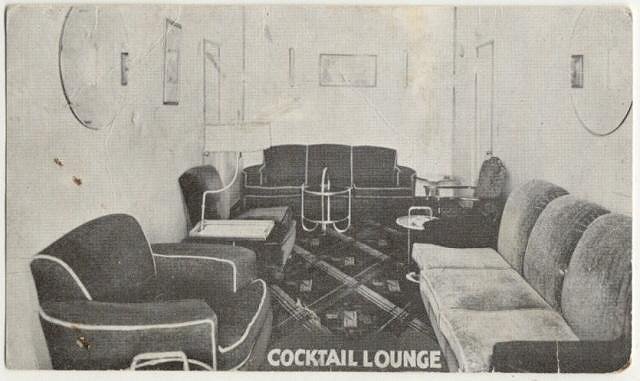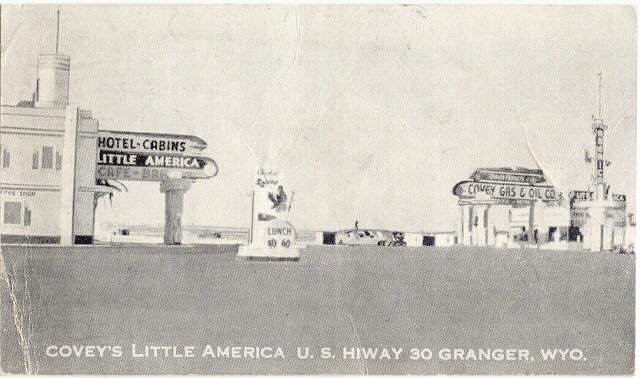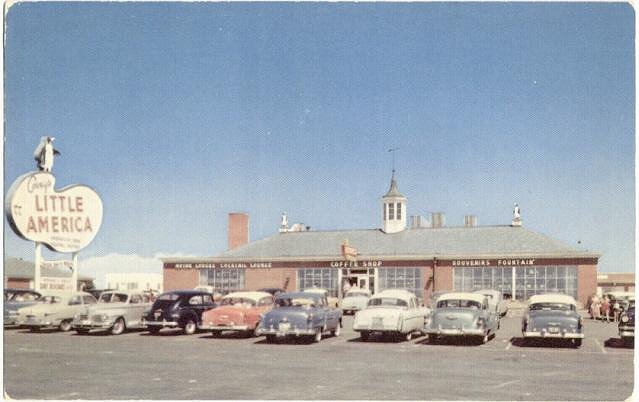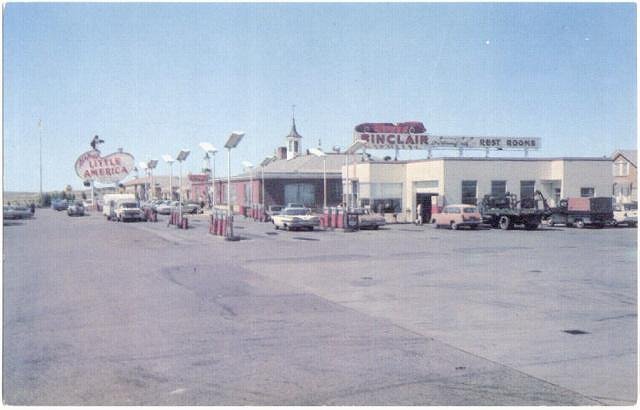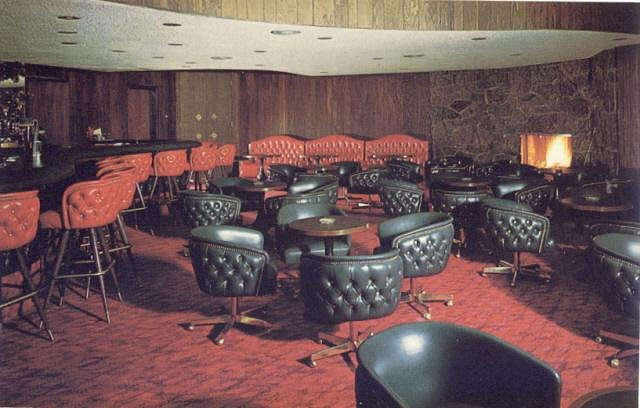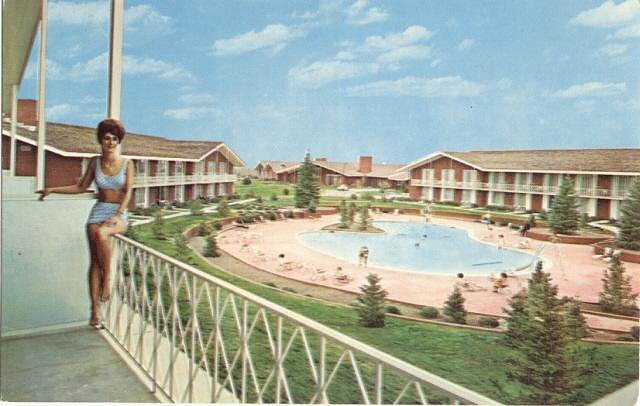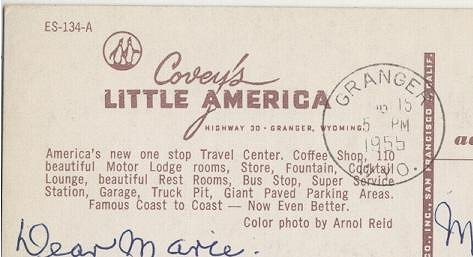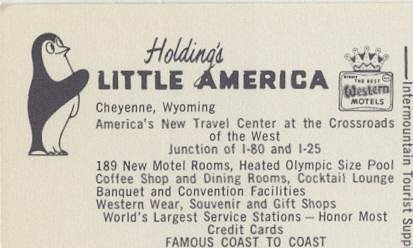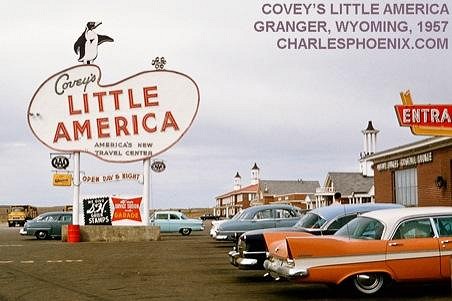Tiki Central / Locating Tiki
Palm Room, Granger, WY (bar)
Pages: 1 9 replies
|
TS
Tiki Shaker
Posted
posted
on
Wed, Dec 9, 2009 5:54 PM
Name:Palm Room Description:
[ Edited by: tiki shaker 2009-12-09 20:14 ] |
|
TS
Tiki Shaker
Posted
posted
on
Wed, Dec 9, 2009 8:19 PM
Found a few more images of it on the internet.
Stuffed penguins? Weird. [ Edited by: Tiki Shaker 2009-12-09 20:20 ] |
|
B
bigbrotiki
Posted
posted
on
Thu, Dec 10, 2009 12:06 AM
Very cool example of an urban island. Love the fake palm trees outside. Wonder what those images on the wall by the penguins depicted, exotic locales? What year might these photos be from...early 30s, late 30s? |
|
B
bigbrotiki
Posted
posted
on
Thu, Dec 10, 2009 12:34 AM
...on further thought, perhaps the concept of "Little America" travel center meant that it incorporated ALL of America's environs: From Alaska (penguins) to Florida (palm trees) |
|
A
abstractiki
Posted
posted
on
Thu, Dec 10, 2009 5:55 AM
Interesting, booths, curved ceiling and round windows outside. Looks a little artdecoish. Is that three penguins in glass boxes in the back of the room!? |
|
OGR

Or Got Rum?
Posted
posted
on
Thu, Dec 10, 2009 7:07 AM
Tiki Shaker, Thanks for the posting. This place always intrigued me as I have 8+ cards from this travel stop and always wondered about the Palm Room. My first 2 shots have the Palm Room listed on the rear. The 3rd is 1955 and does not mention it. The penguins were part of the logo...why? It also changed owners and was rezoned or rebuilt. Mike Robert's did a few of these cards. Sad de-evolution of a once cool roadside Oasis. Big Bro' the deco card is early 40's as it shows a super rare Rockola 1941 Spectavox jukebox. |
|
TS
Tiki Shaker
Posted
posted
on
Thu, Dec 10, 2009 7:39 AM
Found this article about this place. Explains the penguins! http://www.americanheritage.com/articles/magazine/ah/2005/2/2005_2_50.shtml |
|
OGR

Or Got Rum?
Posted
posted
on
Thu, Dec 10, 2009 8:56 AM
TS, Great article, Thanks! |
|
M
Mo-Eye
Posted
posted
on
Thu, Dec 10, 2009 11:51 AM
Tiki Shaker, awesome article! I hate links though, as they almost always cease to work down the road, so I copied and pasted the article here: Queen of the Highways A Pony Express stop for our time In sunshine or darkness, good weather or bad, whether I’m wide awake or dead tired, the most beautiful roadside sight for me is a sign that says WE NEVER CLOSE. I have warm memories of such homes of 24-hour gasoline and coffee: in the Poconos on I-80; another in East Stroudsburg, Pennsylvania; Sandman Plaza in Bordentown, New Jersey; dines Corners on I-40 east of Albuquerque; at the Sacramento River crossing south of Redding, California; on I-90 west of Missoula; a handful on I-80 in Nebraska and Iowa. A few years ago, coming into Wyoming on 80 headed east out of Utah, I saw a billboard that describes my favorite one of all: LITTLE AMERICA Little America, at its present location since 1949, is a 24-hour interstate highway village offering fuel, vehicle repairs, food, a convenience store for travelers, 140 guest rooms, gift shops, and a cocktail lounge. It has its own water department, fire department, post office, postmark, and Zip Code (82929). It has a view of the magnificent snowcapped Uinta Mountains 50 miles away. From 220 to 250 people work there, 70 of them full-time residents, and many others get there by a free shuttle service from 25 or more miles away. Little America’s owner is 77-year-old Earl Holding, who became its manager in 1952. By hard work, diligence, and hands-on management, he and his wife, Carol, made the money-losing truck stop profitable. They personally cooked, waited on tables, made beds, pumped gas, and washed windows. In 1966 they bought the place. From this beginning Holding has built a privately held business empire that includes Sinclair Oil, Sun Valley Resort in Idaho, and the Snowbasin ski resort in Utah, along with other hotels, travel plazas, and around 500,000 acres of Western ranchland. Today he is said to be a billionaire. His son, Stephen, 37, general manager of Holding’s Grand America Hotel in Salt Lake City, says that all his father’s properties “are dear to his heart, but especially Little America, Wyoming. He refers to it as the goose that laid the golden egg.” Little America’s story begins with a man named S. M. Covey. He came to tell it very well. “Away back in the nineties,” he wrote in a promotional brochure half a century later, “when I was a youngster, and herding sheep in this dreary section of Wyoming, I became lost in a raging northeast blizzard and was forced to ‘Lay Out’ all night at the exact place where Little America now stands. That long January night in that terrible storm, with a fifty mile wind and the temperature about 40 below, passed very, very slowly, and oh, how I longed for a warm fire side, something to eat and wool blankets. I thought what a blessing it would be if some good soul would build a house of shelter of some kind at that god forsaken spot. Many times in my heart I’ve promised one there. …” According to Stephen Holding, “Mr. Covey was only a teenager. It took about 40 years before he and his two brothers had the means to come back and build. By then they had been successful at raising sheep and some other businesses.” In 1934 the Covey brothers opened the first Little America, on both sides of old U.S. 30 just south of Granger. Their immediate inspiration came from another remote place. As S. M. Covey tells it, “When I saw Admiral [Richard] Byrd’s picture of [his base] ‘Little America’ in Antarctic[a] and his isolation so many miles from his base of supplies it reminded me of my experience in that Nor’Easter. The thought came back to me to fulfill that promise, to erect a monument and haven of refuge on the spot of my harrowing experience. The name, of course, was a natural, ‘LITTLE AMERICA.’” The Coveys’ haven was relatively modest: 12 guest rooms, 2 gas pumps, and a 24-seat café. According to Dave Mortensen, the general manager of Little America, it was “quaint, with little cabins, a room called the Palm Room for dancing, and a small bar and cocktail lounge. But even then most of the services were open 24 hours a day.” And from the start the connection with Byrd’s supply base was manifested in Little America’s symbol, the penguin. The original operation was destroyed by fire in 1949, and the present Little America went up a few miles to the southeast, on a busier stretch of U.S. 30 that became an even more desirable location when 1-80 replaced that road. Although a private business, not a town, Little America is on most highway maps. The closest community of any size, Green River, is about 25 miles away. The Sweetwater County land is mostly desolate and empty except for sheep, soda ash mines, pipelines, and an occasional natural gas well. America’s transcontinental main street, Interstate 80, came to Wyoming beginning in 1957 and was completed in 1977. The section past Little America, Exit 68, opened in 1968. These highways are the latest manifestation of Wyoming’s tradition of people passing by on their way somewhere else. Little America’s future neighborhood was crossed by the great westward routes of the 1840s and 1850s, the Oregon Trail and the Mormon Trail. The Pony Express rushed through during its brief life, and various freight-wagon roads passed by until the transcontinental railroad superseded them in 1869. Granger, now a tiny settlement with some 130 residents, resonates with echoes of the trails. Before it was a town, it was a Pony Express station and then a stagecoach stop. The Oregon Trail passed a mile or two west. The Union Pacific made Granger a town in the summer of 1868, as the railroad headed west toward its momentous meeting with the Central Pacific in Utah. At the site of the original Little America you can still watch the Union Pacific freight trains rumble by. A few miles east of Little America a lonely historical marker along 1-80 describes the vanished railroad boomtown of Bryan, also built as the Union Pacific crept westward in 1868. Bryan had about 5,000 residents at its peak and served as a railroad repair and supply center until the Union Pacific moved its facilities elsewhere. The Donner Party came through this area in 1846, Brigham Young in 1847, followed by the Gold Rush forty-niners and Mark Twain on the Overland Stage in 1861. I followed them at the age of six in the winter of 1943 with my parents, my infant brother, and our Boston terrier, Cubby, in a 1936 Hudson Terraplane. We were headed to Washington State, and we probably stopped at the original Little America. Thirty-four miles west of Little America was Fort Bridger, now a state historic site. Established as a trading post in 1843 by the famous mountain man Jim Bridger, it became a stopping place for some 300,000 emigrants. Bridger was a prototype Little America, providing provisions, repairs, fresh oxen, travel advice, pasturage, and a place to rest during the long haul. East on 1-80 from Fort Bridger you pass through a nearly lunar landscape. You see a few herds of sheep, a few gas-drilling rigs, some pronghorn antelope—and a billboard for Little America. The sky is almost always light blue, marred only by the white feathers of jetliner contrails. Little America becomes visible several miles away, a huge American flag in front of its neocolonial wood and brick buildings. It’s a place of wind and sky. Elevation 6,426 feet. My experiences at Little America had been limited to hotcakes and coffee, writing postcards at the coffee-shop counter, and stretching my legs in the truck parking lot to the music of idling diesel engines until last April, when I spent five days there, looking and listening. Dave Mortensen, a tall, friendly man who has been at Little America since 1976, showed me around the half-mile-long spread with evident pride. The rooms offer goose-down pillows and 31-inch TV sets. The coffee shop and the dining room seat about 250. The huge menus list more than a hundred items, from granola and eggs Benedict to buffalo burgers, Rocky Mountain trout, and cappuccino. A trucker from Dallas told me he stops at Little America for the steak. “It’s not frozen. Everywhere else the steak is brown.” You can buy The New Yorker at the newsstand. The gift shops sell not only T-shirts and sweatshirts but also crystal chess sets ($1,375), ceramic dog sculptures ($514.98), and a large bronze cast of Frederic Remington’s Bronco Buster ($2,019.98). In the summer about 5,000 travelers enter the main building every day: vacationers, Illinois women going to California to see their grandchildren, gamblers en route to Vegas, people moving to new jobs, seniors rambling, local folk coming for Sunday dinner. I met two groups headed for Utah: a Mormon family of 10, and a women’s softball team from Colorado. Miners and Union Pacific railroad workers stop for a beer on their way home. The beating heart of Little America is the truck fueling center, whose million-square-foot parking lot can accommodate 320 tractor-trailers. “Two-thirds of our sales are generated by truckers, mostly for fuel, repairs, and food,” Mortensen says. Ten stately red fuel tanks stand near the center. Each of them holds 17,000 gallons, and another 80,000 gallons are kept underground. Sixteen tractors can fuel at one time, taking on 55 gallons a minute, fete Roitz, the fuel manager, says he sells an average of 1.5 million gallons a month, typically 125 gallons a truck. There are about 20 ways to pay for fuel, from cash and credit cards to credit accounts. A fast turnaround for fueling is 15 minutes, including an oil and fluids check, cleaning the windshield, and perhaps knocking ice off the headlights. Inside are 17 showers, a TV lounge, a laundry, a deli, and a full selection of truckers’ supplies: tire thumpers, tools, direct-current TV sets, migraine medications, work clothes, paperbacks, CDs, pet food. I spent a lot of time drinking coffee at the fuel center while drivers wolfed down their fried food. They talked about dispatchers, weather, wind delays, and long hours. They wondered about people back home. They spent a lot of time on the phone. Jack Martin, a wiry driver from Dallas wearing a straw hat and a massive Texas belt buckle, who was bound for Chariton, Iowa, with a load of supermarket food, said, “I always stop here. They treat you right, and the food’s good. Did you see that crystal chess set?” A married couple from Salt Lake City hauling frozen food told me they liked the spacious and safe truck parking lot, the “unusual” cleanliness, and the relaxed atmosphere. “And it’s a friendly place for dogs,” the husband said. They were traveling with two. “Too many truck stops are oriented to tourists,” the man added. “Knickknacks and stuffed animals. I needed a windshield wiper once for my Kenworth, and couldn’t find one anywhere else to save my life.” Speaking of what drivers need and don’t need, a notice at the deli counter said, “If you want to add sushi to the menu, make your mark.” The tally stood at 15 yes, 67 no. Two drivers from Georgia, Mildred Greene and a man who said, “Call me Coffeemaker,” were each hauling 45,000 pounds of ice cream from Iowa to Bakersfield, California. They had 20 hours more to go. “This is the right place to stop,” Coffeemaker said. “Your body is ready after 600 miles going west.” Greene said her favorite part of Little America was the clean showers. After the driver complained about being unable to buy windshield wipers for his truck, I went next door to the repair shop and found it sold a full line of them. “If we don’t have one that fits, we make it fit,” said Jason Peden, an assistant manager. The shop also does just about any repair job on cars and trucks, most frequently water pumps, belts, alternators, air conditioning, wheel bearings, and tires. Towing anytime. A truck oil change and lube costs $134.95. At the end of my five days there I took a last walk past the rows of idling trucks, a three-dimensional directory of America’s long-haul carriers. I thought about how Little America, this place where restless people alight for a short while, is a twenty-first-century Fort Bridger and an updated version of the stage and Pony Express stations at Granger. 1-80 is a modern expression of America’s old urge to get somewhere. Little America fulfills our equally old need to stop for food, fuel, shelter, assistance, amusement. And not stay. |
|
M
Mo-Eye
Posted
posted
on
Thu, Dec 10, 2009 11:54 AM
I also remembered that Charles Phoenix just did an email on this a little while ago, and just found it with a nice color picture, and a little more info on the penguin:
A moody watercolor sky casts a perfect glow on a moment of stillness at this king-size roadside beehive of activity. A penguin watches over “America’s New Travel Center” perched high atop an unapologetic freeform amoeba shaped signboard. Little America is spelled out in smart, strong letters set politely, slightly tilted below the handwritten name of the man that built the deluxe 24-hour stop spot on the well-worn road between Cheyenne and Salt Lake City in 1949. It soon became famous for having “the largest gas station in the world.” The best poser parking space is graced with the perky presence of an orange creamsicle-colored ‘57 Plymouth Belvedere. The optional factory tinted glass, from the exterior, gives the interior a tropical aquarium look. Above the Plymouth the entrance sign stands out against the thin mint brick Early American-meets-modern style buildings. (From now on lets call this hybrid style “Early Amoderan.”) It goes so well with the Antarctic theme Mr. Covey was going for when he named his nomad village for the Antarctic camp pioneer polar explorer Richard Byrd set up in 1928. This year Little America celebrates its sixtieth anniversary. Though I understand it has been updated and stripped of its original style at least one thing has been there since the beginning, the other Penguin. In keeping with the Antarctic theme Mr. Covey wanted to have a live penguin in a cage on display for his customers. So he did what anyone would do that wants a penguin he ordered one from a penguin dealer in the Antarctic. When the bird arrived it was dead. So Mr. Covey did what anyone would do. He called a taxidermist and had the poor thing stuffed. To this day the dead penguin remains mounted on a fake block of ice in the hotel for us all to enjoy! |
Pages: 1 9 replies

